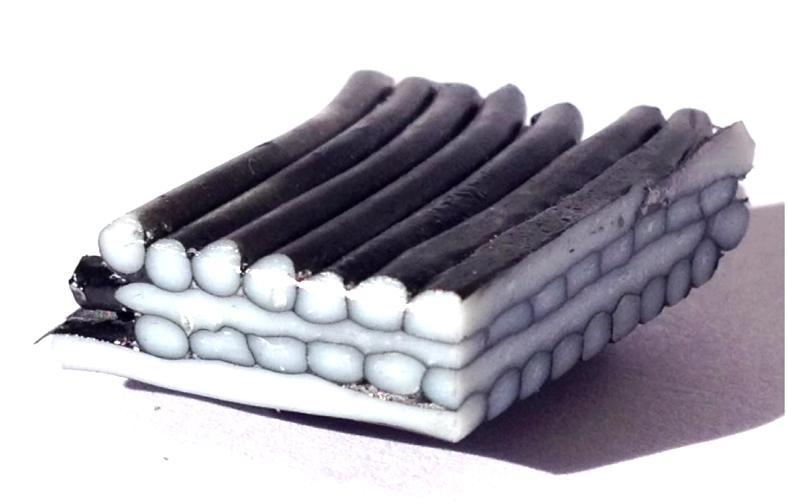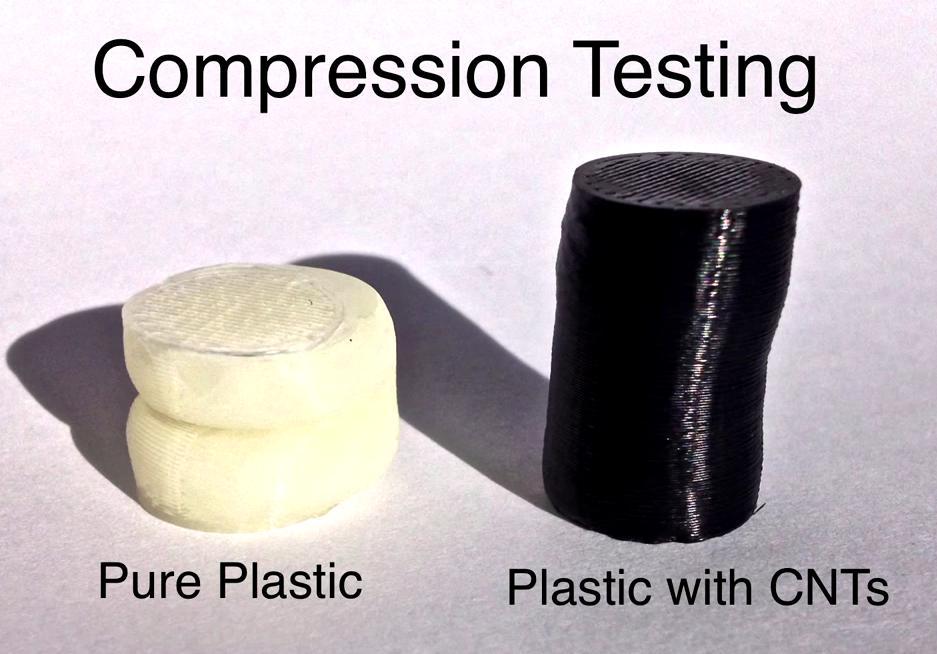Carbon Nanotubes (CNTs) are a relatively new nano material. They were first produced, as well as recognized, in the early 1990’s. Over the years, these single layer rolls of interconnected carbon atoms have dropped drastically in price from $1500 a gram in 2000 to about $35-$50 a gram today. This has enabled an explosion of research around CNTs as well as products already being produced out of the material. CNTs are traditionally extremely strong, great thermal and electric conductors, and are able to stand up to a great deal of pressure without deformation.
We have already seen a couple of companies announce carbon nanotube composite 3D printer filament. The main purpose of such filament has been to increase the electrical conductivity of printed products. Future applications for such filament may be for 3D printing electronic devices in which all the electrical components have already been integrated. Because most of these CNT composite filaments have only a small amount of CNT’s within them, which are not connected with one another, the inherent strength of the interconnected carbon atoms are not passed on to the printed objects themselves.
One man, by the name of Brandon Sweeney, who is a chemical engineering doctoral candidate at Texas Tech Univerisity, has deviated from the traditional methods of using CNT’s for 3D printing. One problem that he came upon, when using an FDM based printer, was that the plastic prints lacked strength at the points where each layer connected to the one below it. If a printed object were to be bent or torn apart, the point of failure is almost always between two of the layers of a that object. Sweeney, however, came up with a solution.
He found that the conductive properties of CNT, meant that when the material was exposed to microwave radiation, the CNTs would heat up quickly and extensively, while the polymer filaments often extruded from 3D printers would remain relatively cool. What Sweeney wanted to do was fuse together all the layers in a polymer 3D print, without affecting the overall shape of the object printed. The CNTs were the perfect solution.
What Sweeney did was obtain ordinary 3D printer filament, and dunked it into a CNT bath. This created a thin layer of CNTs on the outside of the filament. He could then print an object, direct microwave radiation at it (a microwave oven would work), and overcome the main strength issue that he had run into in the past. When the object is struck with the radiation, the thin layers of CNT coating heat up quickly, fusing the layer of plastic filament together at the point of connection, while leaving the remainder of the plastic cool, and in its current form. Not only does this allow the object to bond together in a stronger manner, but also the thin layers of CNTs between each layer of filament makes the compression of the object much more difficult. The properties of strength are thus partially transferred to the finished print. Sweeney is continuing his research into this fascinating approach, and along with Micah Green, associate professor in the Department of Chemical Engineering , and Mohammed Saed, professor of electrical engineering, at Texas Tech University, have secured intellectual property rights to the new technology.
Check out the TED talk that Sweeney gave a few months back on this very technology. Let us know what you think about the future application of carbon nanotubes within 3D printing at the 3DPB.com CNT forum thread.
Subscribe to Our Email Newsletter
Stay up-to-date on all the latest news from the 3D printing industry and receive information and offers from third party vendors.
You May Also Like
3D Printing Unpeeled: New Arkema Material for HP, Saddle and Macro MEMS
A new Arkema material for MJF is said to reduce costs per part by up to 25% and have an 85% reusability ratio. HP 3D HR PA 12 S has been...
3D Printing News Briefs, January 20, 2024: FDM, LPBF, Underwater 3D Printer, Racing, & More
We’re starting off with a process certification in today’s 3D Printing News Briefs, and then moving on to research about solute trapping, laser powder bed fusion, and then moving on...
3D Printing Webinar and Event Roundup: December 3, 2023
We’ve got plenty of events and webinars coming up for you this week! Quickparts is having a Manufacturing Roadshow, America Makes is holding a Member Town Hall, Stratafest makes two...
Formnext 2023 Day Three: Slam Dunk
I’m high—high on trade show. I’ve met numerous new faces and reconnected with old friends, creating an absolutely wonderful atmosphere. The excitement is palpable over several emerging developments. The high...


































